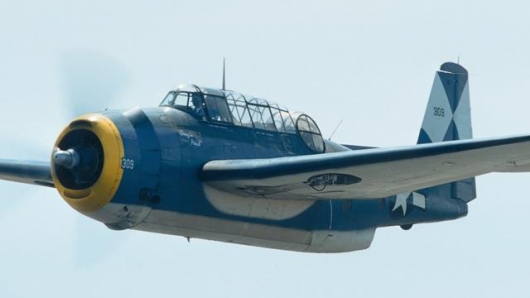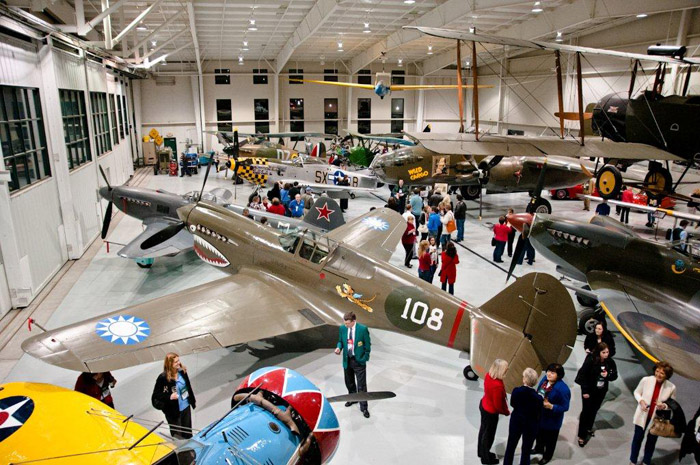The best surprises come in really big packages. Even better when the packages are WWI and WWII military aircraft. I had rather low expectations of my visit to the Military Aviation Museum in Virginia Beach, VA. I had done some research and read mixed reviews stating the planes were great but not much else to see. The museum had been on my hit list for sometime but I hadn’t gotten around to it. One reason is the location. The Hampton Roads area runs on the military and Oceana is the biggest Naval Air base in the US. The catch with this museum, it’s in the middle of farm country and not in a downtown VA Beach, Norfolk or Newport News. You basically have drive down to the border of North Carolina to get to it. So, on a sunny Monday morning in October I made my way south. In the end I would be happy I did.
A Museum With No Map
The Military Aviation Museum is open year round excerpt for Christmas and Thanksgiving. Entry fee is $12 for adults and you get a sticker in the shape of wings as your ticket. The main building is filled with artifacts from WWI and WWII, mostly uniforms, cars and artillery. There is also four hangers where all the planes are housed. The slightly grouchy woman at the desk informed me there was no map to guide you around so it’s basically a self guided tour. I started in the main museum checking our the uniforms, artillery, medals and cars. For a history buff, stuff like this is really cool and I enjoyed it. The lighting was poor so some of the plaques were hard to read and some stuff didn’t have any descriptions. It was also laid out in an odd fashion, with no rhyme or reason to the flow. Either way it was cool, but I wanted to see the aircraft, problem was I didn’t really know how to get into the hangers and there was nobody around to ask. I went outside, followed the signs for the Naval Aircraft hanger, walked around to the backside of the building and BOOM! A whole hanger filled to the brim with WWII American Naval Aircraft. The day was looking up indeed.

America’s Navy
This 15,000 square foot hangar is home to many of the museum’s US Navy aircraft. Planes like the PBY Catalina, Corsair, Skyraider and TBM Avenger tucked inside along with the unique DeHavilland Dragon Rapide and the N3N Canary. I spoke to a volunteer and he informed me they have had wedding ceremonies and their formal dances during the WWI and WWII air shows. This hangar was what I was looking for. I was able to feel the propellers and touch the wing tips of some of the most iconic aircraft in military history. The pictures of the planes speak louder than my words, I will have a link to a photo album of all the aircraft I saw at the end of the blog.
In The Army Now
Connected to the main museum building on the west side is the Army Hangar. Another massive 15,000 square foot hangar is where I found US Army Air Corp aircraft mixed in with a massive array of Great Britain, Russia and other countries. My favorites aircraft were the P-51 Mustang, the Curtiss P-40, the B-25 Mitchell, the Spitfire and the Hurricane. Seeing as it was a Monday there weren’t to many people around, in the silence, examining these beasts of the air you could really feel their power and need to fly.

A Guided Tour
As I explored the Army hangar some more, a museum volunteer let me know that there would be a demo flight of a Gruman TFB Avenger torpedo bomber, the same plane George Bush Sr. flew in WWII. This got me excited but it wouldn’t be for a couple more hours. The volunteer also said there would be a guided tour of the WWI, Fighter Factory and Cottbus hangar to pass the time. So I headed off up the road to the Cottbus hangar, not even really knowing what it was.

The tour was led by a WWII veteran who really knew his aircraft. Turns out the Cottbus hangar was a restored WWII Nazi mobile hanger that could be built up and taken down quickly. It was used to house training and combat ready Nazi Aircraft. Sadly the hanger design came from a German WWI ace Gotthard Sachsenberg who spoke out against the Nazi regime and was stripped of his company when he was discovered to be part Jewish. Inside the hanger are many Nazi area combat and transport planes, many in original condition. Almost all are still decked out in Swastikas and still flying. You can find many a Fokker and the much sought after Messerschmitt Fighter.

Fighter Factory
The Fighter Factory is the maintenance facility where all of the aircraft on display at the museum receive their annual inspections and most of the maintenance work is performed. The greatest thing about the factory is all but two aircraft are airworthy. The hangar is 16,000 square feet. The building includes an open hangar space, workshops, parts storage rooms, a small paint room and offices. There were a few aircraft being worked on but you aren’t allowed past a certain point, so it was onto the WWI hanger.

The Great War Hanger
This 15,000 square foot WWI hangar is reminiscent of the French barns that served as hangars during the Great War. This hanger is pure beauty, the smell of fresh-cut timber permeates sense of smell. It features smaller hangar doors facing the cross-winds taxiway, which can be opened onto grass parking for the lightweight wood and fabric airplanes housed in the hangar. The World War One-era aircraft housed, they are light and easy to move outside during good weather. There are many French, German and British biplanes and triplanes all airworthy.

Flight Demos
By far the best part of the day was the flight demo. There was a couple from California on tour that had purchased a ride in a 1930’s era de Havilland Tiger Moth biplane. It had a beautiful yellow livery and when it started up it was very quite. I am use to single engine takeoffs, but the Moth barely used any runway and seemed to crawl into the sky, slowly climbing and doing laps in the pattern. From talking to pilot the controls on the Moth are very tricky and require very small inputs or the plane becomes difficult to control. One of these days I would like to get up in one.

The highlight of the day was the Grumman TBF Avenger demo. The volunteers who work at the museum have an incentive program where once they hit 500 hours of volunteering they get to go up for 30 minutes in a WWII aircraft. When they hit 1000 hours they get to go up for an hour. The Avenger was built to drop torpedo into the water for enemy ships and subs and was meant to be stored on aircraft carriers. The wings are retractable so the aircraft can be stored the ship’s deck. It is a dual cockpit, with presumably the pilot in front and navigator in back. When this puppy fires up you want to be a good distance away. It has 14 cylinders piston driven engine with 1,700 hp so its loud and frequently backfired during start-up. The takeoff was amazingly short which make sense because the Avenger was meant for short takeoffs on the aircraft carriers. The sound though on takeoff was amazing, as it flew overhead the ground rumbled and vibrated, you could really sense the power and strength of the plane. It stayed in the pattern mostly and did some low flybys for the crowd and a couple of cross field turns to demonstrate its maneuverability. It landed far down the runway and ate up little runway.

I am glad I took the time to visit the Military Aviation Museum, it really turned out to be a great not. I might have gotten lucky being able to see the flight demo’s, I’m sure they don’t happen everyday. The aircraft on static display are something to behold. The are an important part of US and world history and the craftsmanship and technology is extremely impressive. Kudos to the volunteers, they really love aviation. It was the best $12 I have spent in a long time and I highly recommend a visit.

